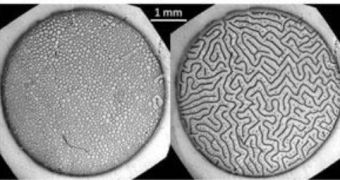The first pictures of the spatial distribution of a magnetic field penetrating a superconductor were presented by a team of researchers at the U.S. Department of Energy's Ames Laboratory. They show strange two-dimensional equilibrium patterns and intricate models.
Soap-foam like structures display on the surface of superconductors were now related to the macroscopic physical properties, magnetism being the most important, in a recent research by Ruslan Prozorov, who successfully proved that the shape of the entire sample causes the formation of a pattern topology and an overall magnetic behavior of the entire system.
"You can have the same volume and same mass, but if you just change the shape, you get a different type of response from the sample and a different type of geometry of the equilibrium field pattern," Prozorov explained. "The discovery has reopened the whole field of equilibrium in type-I superconductors, which had gone dormant because it was considered closed."
Superconductors are an entire class of materials that display an extremely interesting property, exactly zero electrical resistance and the exclusion of the interior magnetic field (what is known as the Meissner effect) at extremely low temperatures, usually below -140 degrees Celsius. They are used in many applications, like MRI medical imaging scanners, levitating trains and power lines.
The new pictures of the pattern of two-dimensional tube shapes that Prozorov describes as looking like soap foam, contradict the previous pictures of the equilibrium state, the Landau laminar pattern and he suspects that the new arrangements are caused by shapes without two flat surfaces, such as spheres, hemispheres, pyramids and cones.
"We observed the foam, or tubular, phase in all of these sample shapes, and we don't have the Landau phase at all," he said. "So it's the foam phase that's the equilibrium state of the system. Most of the past studies were done on samples with flat surfaces, that's why people never observed this previously for decreasing magnetic field."

 14 DAY TRIAL //
14 DAY TRIAL //